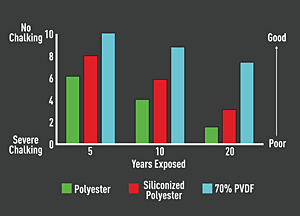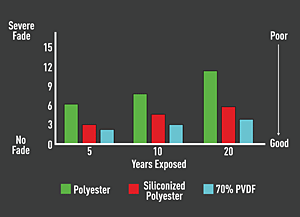AAMA 2605-05 Sets High Standards for Coated Aluminum Extrusions and Panels
|
||||||
When formulated into a coating composition containing a minimum of 70 percent PVDF resin, the resultant coatings exhibit superior color and gloss retention, chalk and corrosion resistance, flexibility, stain resistance, overall durability, and can stand up to direct sun, extreme temperature variations and acidic pollutants without fading. Coatings with 70 percent PVDF meet or exceed the AAMA 2605-05 specifications.
During manufacturing, a chemical bond is created between the extruded aluminum and the paint to resist chalking and fading. For best results, before the finish is applied, aluminum cladding goes through a five-step pre-treatment process to ensure the finish adheres smoothly. Unlike roll-form aluminum, clad extrusions are formed first and then painted. This results in superior adhesion and a consistently thick finish so that clad products retain color and gloss qualities.
Industry Standards
Environmental conditions can cause coatings to fail. Precipitation, ultraviolet rays, heat, and temperature extremes are all capable of breaking down exposed surfaces. Standards were developed to assure the building community that coatings on extruded aluminum retain their integrity. Adherence to these standards enables architects to make reliable projections about product performance.
The American Architectural Manufacturers Association (AAMA) is a source of finish performance standards, product certification and educational programs for the window, door, and skylight industry. AAMA maintains specifications for all fenestration materials. For years, architects recognized 603 and 605 as standards for organic coatings on architectural aluminum and panels. These have been superseded by new specifications that will enhance architects' ability to specify the right level of performance for factory spray-applied organic coatings for project requirements. The AAMA Document Management Committee (DMC), in conjunction with AAMA's technical staff, reviews all documents that have not been revised in the last five years to determine if new information is available or necessary. If needed, the DMC asks the appropriate committee to review and refine the document. In the case of 2605, the AAMA Finishes Committee last refined the document in 2005 to support the latest industry knowledge. AAMA 2605-05 is the highest industry standard available, ensuring ten-year color retention and chalk resistance. Adherence to AAMA 2604-05 (five-year color retention and chalk resistance) and AAMA 2603-02 (one-year color retention and chalk resistance) offer less, though better and good performance levels, respectively.
The most recent AAMA standards reflect good, better, and best performance for extruded aluminum clad windows:
Best: 2605-05, 10 years color retention and chalk resistance
Better: 2604-05, 5 years color retention and chalk resistance
Good: 2603-02, 1 year color retention and chalk resistance
The purpose of these standards is to help architects, contractors, and building owners specify factory-applied organic coatings that will provide and maintain a superior level of performance in terms of coating integrity, exterior weatherability, and general appearance over many years. The standards also give buyers an added measure of quality assurance and serve as a reference point for regulators.
AAMA 2603 applies to polyester and acrylic coating and is intended primarily for interior, light commercial and residential-grade coatings of at least 20 microns (0.8 mil) thickness. A one-year South Florida weathering test is optional.
AAMA 2604 and 2605 apply to coatings of at least 30 microns (1.2 mils) thickness that are intended primarily for commercial and architectural-grade applications. AAMA 2604 applies to silicon polyester coatings; AAMA 2605 applies to coatings that contain 70 percent PVFD. The same ASTM test methods and performance criteria are used to evaluate color uniformity and specular gloss, which is a measure of the light reflected by the surface of a material. Specular gloss can be inherent in the material, or the result of the molding process or surface texture. Gloss is always referenced against a standard. Gloss can also be affected by environmental factors such as weathering or surface abrasion. In addition, the same impact resistance and chemical resistance are used in both standards. Both involve test methods and criteria not required under 2603-02. While AAMA 2604 addresses complete coatings systems based on 30mg of chrome pretreatment; AAMA 2605 applies to high-performance coatings based on 40mg of chrome pretreatment Both coating specifications may use a non-chrome pretreatment process. In places where there are environmental concerns, chrome pretreatment may not be allowed.











